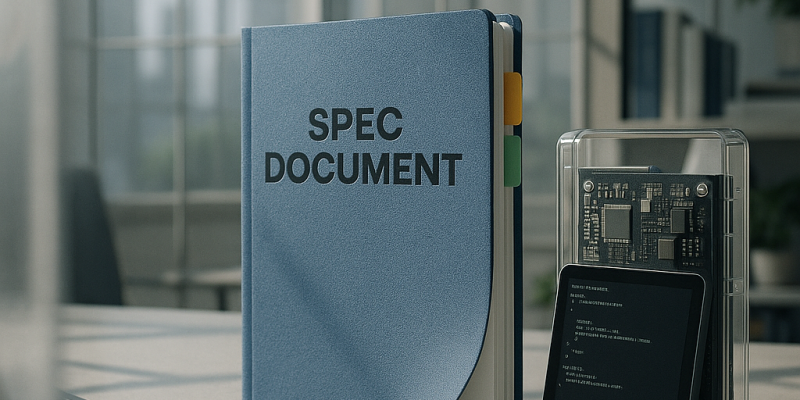Spec-Driven Development Is Going Mainstream — GitHub’s Spec Kit Leads
Published Nov 20, 2025
Tired of brittle AI code and lost prompt history? This brief tells you what changed, why it matters, and what to watch next. GitHub’s Spec Kit updated to v0.0.85 on 2025-11-15 and the spec-kit-plus fork advanced multi-agent templates (v0.0.17, 2025-10-28). Academics released SLD-Spec (2025-09-12) achieving 95.1% assertion correctness and ~23.7% runtime reduction for complex loops, and SpecifyUI (2025-09-09) introduced SPEC to improve UI fidelity. Why it matters: spec-first workflows promise faster first-pass correctness, clearer audits, and less tech debt but demand upfront governance, training and tooling—estimates show 20–40% feature overhead. Risks include spec ambiguity, model limits and growing spec/context complexity. Immediate actions: pilot Spec Kit templates, add spec review gates and monitor CI validation and real-world spec-as-source case studies. Confidence that SDD becomes mainstream in 12–18 months: ~80%.
Federal vs. State AI Regulation: The New Tech Governance Battleground
Published Nov 16, 2025
On 2025-07-01 the U.S. Senate voted 99–1 to remove a proposed 10-year moratorium on state AI regulation from a major tax and spending bill, preserving states’ ability to pass and enforce AI-specific laws after a revised funding-limitation version also failed; that decision sustains regulatory uncertainty and keeps states functioning as policy “laboratories” (e.g., California’s SB-243 and state deepfake/impersonation laws). The outcome matters for customers, revenue and operations because fragmented state rules will shape product requirements, compliance costs, liability and market access across AI, software engineering, fintech, biotech and quantum applications. Immediate priorities: monitor federal bills and state law developments, track standards and agency rulemaking (FTC, FCC, ISO/NIST/IEEE), build compliance and auditability capabilities, design flexible architectures, and engage regulators and public comment processes.
Aggressive Governance of Agentic AI: Frameworks, Regulation, and Global Tensions
Published Nov 13, 2025
In the past two weeks the field of agentic-AI governance crystallized around new technical and policy levers: two research frameworks—AAGATE (NIST AI RMF‐aligned, released late Oct 2025) and AURA (mid‐Oct 2025)—aim to embed threat modeling, measurement, continuous assurance and risk scoring into agentic systems, while regulators have accelerated action: the U.S. FDA convened on therapy chatbots on Nov 5, 2025; Texas passed TRAIGA (HB 149), effective 2026‐01‐01, limiting discrimination claims to intent and creating a test sandbox; and the EU AI Act phases begin Aug 2, 2025 (GPAI), Aug 2, 2026 (high‐risk) and Aug 2, 2027 (products), even as codes and harmonized standards are delayed into late 2025. This matters because firms face compliance uncertainty, shifting liability and operational monitoring demands; near‐term priorities are finalizing EU standards and codes, FDA rulemaking, and operationalizing state sandboxes.
Copyright Rulings Reshape AI Training, Licensing, and Legal Risk
Published Nov 10, 2025
No major AI model, benchmark, or policy breakthroughs were identified in the past 14 days; instead, U.S. copyright litigation has emerged as the defining constraint shaping AI deployment. Key decisions—Bartz v. Anthropic (transformative use upheld but pirated-book libraries not protected) and Kadrey v. Meta (no demonstrated market harm)—clarify that training can be fair use if sourced lawfully. High-profile outcomes, including Anthropic’s proposed $1.5B settlement for ~500,000 works, underscore substantial financial risk tied to data provenance. Expect increased investment in licensing, provenance tracking, and removal of pirated content; greater leverage for authors and publishers where harm is provable; and likely regulatory attention to codify these boundaries. Legal strategy, not just technical capability, will increasingly determine AI commercial viability and compliance.
EU Weighs One-Year Delay to AI Act After Big Tech Pressure
Published Nov 10, 2025
The EU is weighing changes to the AI Act’s enforcement timeline via the Digital Omnibus (due 19 Nov 2025), including a proposed one‐year delay of high‐risk rules (Aug 2026→Aug 2027) and targeted simplifications that could exempt narrowly scoped administrative systems. Motivated by Big Tech and U.S. pressure, delays in technical standardization, and member‐state calls for clearer, less burdensome compliance, the proposals would give firms breathing room but prolong legal uncertainty. Consumers could face weaker protections, while global regulatory norms and investment dynamics risk shifting. Any postponement should be conditional and phased, preserving non‐negotiable safeguards—transparency, impact assessments and risk mitigation—while aligning rules with available standards and tooling.
Leaked EU 'Digital Omnibus' Could Weaken AI Rules Worldwide
Published Nov 10, 2025
A leaked draft of the European Commission’s “Digital Omnibus” proposes major simplifications to the EU AI Act—delaying penalties until August 2, 2027, exempting some narrowly purposed systems from high‐risk registration, and phasing in AI‐generated content labels. Driven by industry lobbying, U.S. pressure, and regulatory fatigue, the draft has drawn warnings from EU lawmakers who fear weakened safeguards for democracy, rights, and safety. If adopted, the changes could shift investment and deployment timelines, complicate oversight of malicious uses, and prompt other jurisdictions to follow suit, potentially diluting global standards. Ambiguity over what counts as “high‐risk” creates a contested regulatory gray zone that may advantage incumbents and undermine AI safety and transparency ahead of the proposal’s Nov. 19, 2025 presentation.





